Scrum Implementation: A Step-by-Step Process Explained in 2025
Scrum implementation may seem overwhelming if you’re new to this framework. In truth, once you define each stage of the Scrum process, understanding what you need to do becomes much easier. We’re sharing the fundamentals to help everyone up their Scrum game.
If you’re interested in using the Scrum framework but are unsure where to start, this article will guide you through the main steps of the process. We’ll break down each crucial step of successful Scrum implementation so you can breeze through your next project.
The core steps covered in this guide will teach the importance of building a strong team, why you need to have deep knowledge of your product and how to prepare for your first sprint. We’ll also cover what to expect during and after a sprint. For a more comprehensive guide to Scrum, we recommend checking out our “What is Scrum?” guide.
Before we go through the Scrum process, it’s important you have the right tools. The best project management software offers features that development teams can use to complete their sprints. monday.com is our favorite for all types of project management. You can see why it’s popular among scrum teams in our monday.com review.
How Scrum Implementation Happens
Scrum is implemented in different stages, with the end goal being to produce a functioning product that serves the end user. Each stage caters to the pillars of Scrum: transparency, inspection and adaptation. This means maintaining open communication, carrying out continuous evaluation of processes and making changes where necessary.
Avoid Costly Project Management Mistakes – Get Free Tips Today!
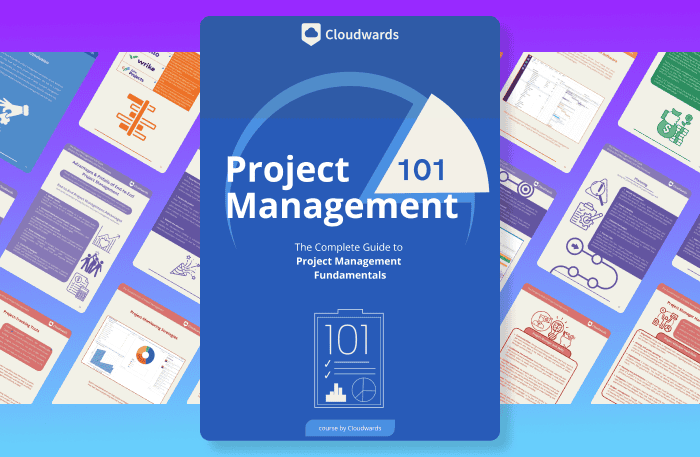
- Discover 10 fundamentals of project management
- Understand step-by-step plans for PM execution
- Learn tips to avoid 5 common mistakes by beginners
1. Build Your Team
The first step is to build your team. This involves finding a product owner, a scrum master and a development team. It’s important to keep the scrum team small — ideally no more than nine members total. This supports the fundamentals of Scrum, such as strong communication, effective use of resources and simple organization.
Each team member has a vital role to play. The product owner is the lynchpin between stakeholders and the scrum team. The scrum master plans and manages sprints, and the development team is responsible for building the product. You can learn more about each role in our guide to Scrum roles and responsibilities.
It’s important that team members possess a blend of hard and soft skills. These include:
- Ability to adapt
- Good communication
- Excellent organizational skills
- Familiarity with problem-solving
- Openness to professional feedback
- Experience using the Scrum framework
2. Create the Product Backlog
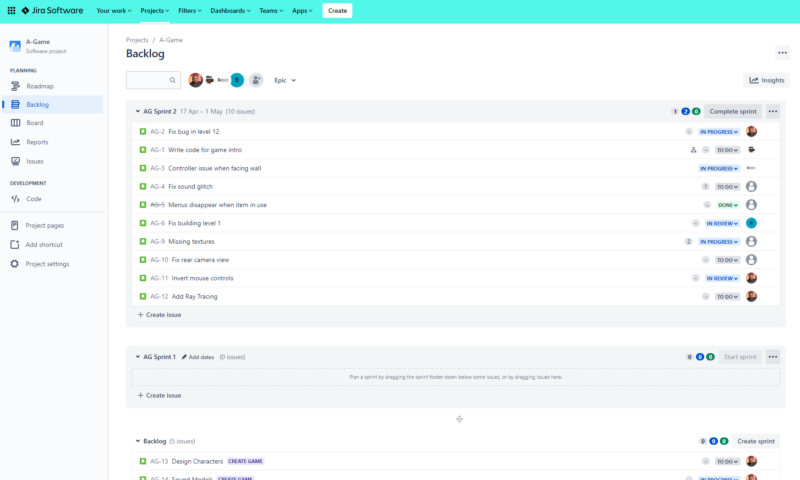
The product backlog is a wishlist of features stakeholders want in a product. It’s not set in stone, though, and can change depending on issues or new feature requirements. The scrum team uses the backlog as a point of reference, helping them decide which sections of the backlog to prioritize.
Within a backlog you’ll see two core items: epics and stories. Epics give the scrum team an overview of what’s ahead. “Launch editorial app” is one example. User stories go into more detail, offering a granular explanation of what’s required. It’s common for a single epic to be broken down into multiple user stories.
The product owner is typically in charge of creating the backlog. To make sure it’s in the best shape possible, it’s important to have a deep understanding of the product you’re building. This comes from the initial conversations with the stakeholders.
3. Plan Your Sprints
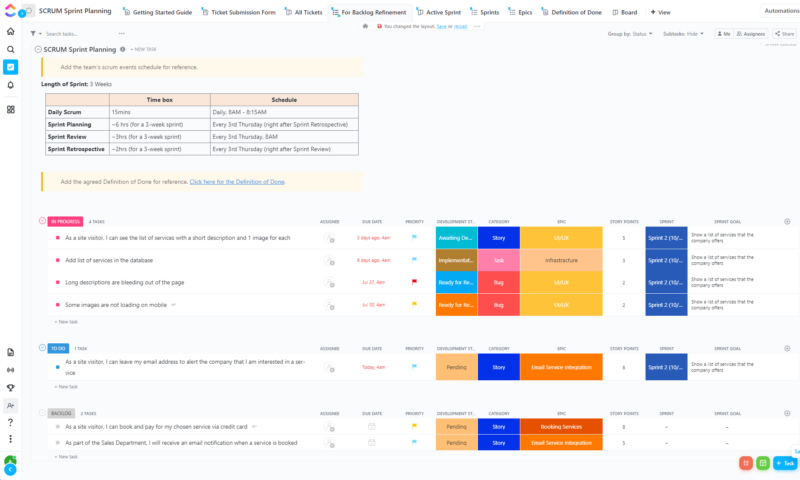
The first step in sprint planning is to confirm its duration. Sprints can last anywhere from one to four weeks, depending on the level of effort required to complete the work delegated for a specific sprint.
Most of the planning occurs in a sprint-planning meeting, which the scrum team attends. During the meeting, you’ll define the goal of the sprint and allocate items from the backlog to team members. It’s also an opportunity for the team to ask questions and learn more about the work ahead. Here’s what to expect during a sprint:
- Initial sprint-planning meeting: This is a time to set goals, ask questions and confirm the sprint length.
- Daily stand-up meeting: This 15-minute meeting can be used to discuss progress, raise issues and adapt where necessary.
- Sprint review: This is an opportunity to show your work to the stakeholders for approval, analyze processes and allow the scrum team to voice any issues.
- Sprint retrospective: The scrum teams come together to discuss how they can avoid issues in future sprints and refine processes to improve the workflow.
4. Run Your First Sprint
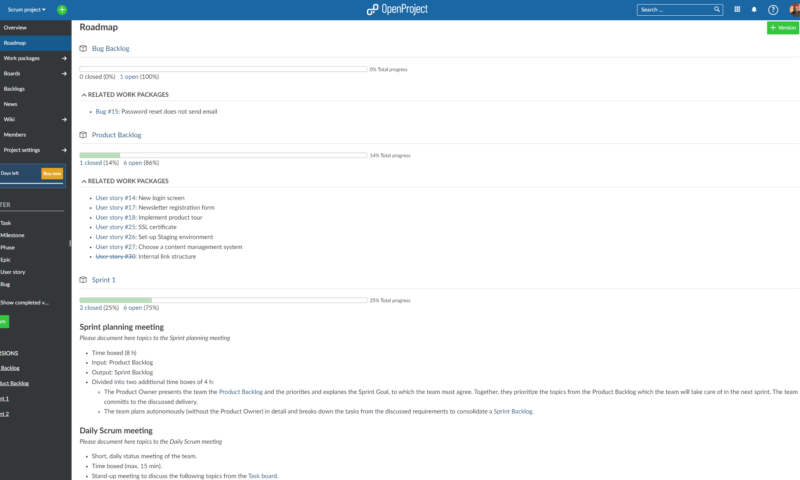
Running your first sprint is the best way to see if you can execute what you developed in the planning stage. You’ll gather feedback from your team through daily scrum meetings, giving them an opportunity to share what’s working and what you can improve. You can then make adjustments where necessary to ensure you can keep moving forward.
Your initial sprint is also a good opportunity to test-run the project management software you’ve elected to use. You can see if it helps foster a smooth workflow and ascertain whether it’s supporting you in achieving your goals. Again, gather feedback from the team and have some backup options on hand if you need to switch software.
5. Review Your Process and Incorporate Feedback
Once your first sprint is complete, you will conduct a sprint review. This is an opportunity to show off your work, gather more feedback and see how close to your initial goal you came. Following that, you’ll move into a sprint retrospective, which is an opportunity for everyone, including stakeholders, to discuss how to implement improvements in future sprints.
Don’t be disheartened if it doesn’t go perfectly. The Scrum framework is designed to be flexible, and it encourages the use of feedback to improve processes. Use what you learned to make adjustments for upcoming sprints. With a bit of trial and error, you’ll discover how to best use the framework to keep your team engaged and succeed in any project you tackle.
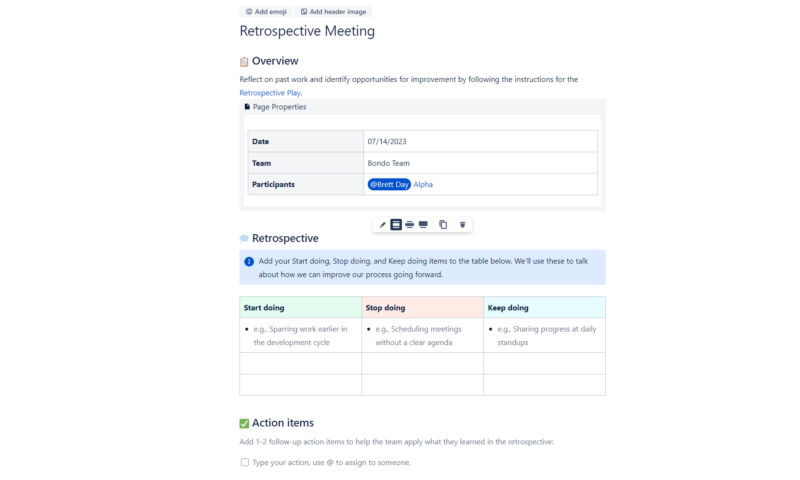
record all the details for your retrospective.
Benefits of Scrum Implementation
Scrum practices have supported teams since the methodology’s inception in the early ’90s. The purpose is to create a more efficient workforce that can refine processes through continuous improvement and open communication within the team. Below are some of the core benefits to implementing Scrum practices within Agile software development.
- More efficiency: Breaking down large tasks into smaller goals mitigates the feeling of overwhelm and provides the team with a smoother, clearer work process.
- Improves communication: Scrum encourages teams to be open and honest about how they feel about the work and the processes in place. Improving communication helps you overcome issues much more quickly.
- Increases quality: Through testing and continuous stakeholder feedback, software teams can refine a product and ensure it’s in the best shape possible before launch.
- Allows scalability: Because Scrum improves efficiency, it opens the door to working on more products within a certain space of time. This allows you to scale your business and bring in more clients.
Final Thoughts
Successful Scrum implementation will depend on how well you implement preparation and communication. Building the right team, having deep knowledge of the product and delegating tasks accordingly will also be key to your success.
Because Scrum leaves room for the unpredictability of building a product, not everyone’s process will be the same. Factor in different work experience and personality types, and you’ll find that Scrum projects can differ significantly. To help keep on top of it all, remember to make use of the best software tools specifically built for the Scrum framework.
Did you find this guide useful? What other areas of project management would you like us to explain? How has Scrum benefited your project workflow? Let us know in the comments. Thanks for reading.
FAQ: Scrum Process
Scrum implementation involves using the Scrum framework in your project.
The first step is to build your Agile and scrum teams by identifying candidates with the right skill sets to complete the project. You can then identify the goal of your Scrum project, break it down into tasks and put a plan in place to complete the work within a given timeframe.
The implementation phase includes completing tasks within a specific timeframe (typically two to four weeks). This phase is better known as sprint implementation.
To implement Scrum, you must first build your scrum team, develop a product backlog and plan an upcoming sprint. The next phases include implementing your sprint, reviewing it and holding a retrospective.


